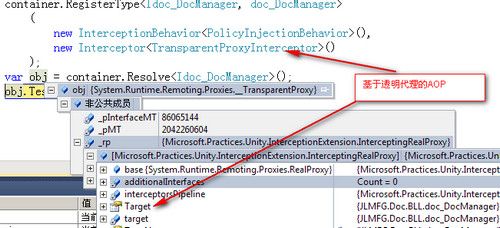.Net中的Interception--一个简单的AOP框架学习
最近翻手头的dll文件时无意中发现了一个Interception实现,这个框架比起目前流行的AOP框架显的比较简漏,但却很好的体现出了.net下AOP是怎么实现的,于是就整理出来。
在.Net Unity2.0中的Interception,按三种方式实现:
1.TransparentProxy/RealProxy Interceptor 即Remoting代理机制。

2.Interface Interceptor 即动态代码 (Emit编程)实现

3.Virtual Method Interceptor 也是动态代码实现,Emit编程基本类似于IL编程了。

需要注意的是使用VirtuatMethodInterceptor后,PolicyInjectionBehavior会被忽略,通过Resovle获取的始终是继承被拦截类的子类实例
而透明代理与接口方式在全部移除匹配策略后(Policy,就是这个类不需要拦截了),Resolve返回的是原始类(非代理类)
实例拦截与类型拦截
1.实例拦截
TransparentProxy 与 Interface Interceptor 属于实例拦截,所谓实例拦截就是被拦截对象完整而独立的在内参中存在。Client端通过代理类与被拦截对象发生通信(方法调用)。

2.类型拦截
Virtual Method 方式属于类型拦截,内参中不存在被拦截类型的实例,拦截框架通过动态代码生成被拦截类型的子类型程序集,该程序集被加载后对应的子类型被实例化于内存中与Client发生通信

下面针对TransparentProxy/RealProxy 与 Interface Interceptor帖出手头上dll实现的代码
1.TransparentProxy/RealProxy实现
using System.Reflection;
using System.Runtime.Remoting.Proxies;
using System.Runtime.Remoting.Messaging;
using System.Runtime.Remoting;
internal class TransparentProxy : RealProxy
{
// Fields
private readonly MarshalByRefObject m_Target;
// Methods
public TransparentProxy(MarshalByRefObject target)
: base(target.GetType())
{
this.m_Target = target;
}
public static object GetProxy(MarshalByRefObject target)
{
TransparentProxy proxy = new TransparentProxy(target);
return proxy.GetTransparentProxy();
}
public override IMessage Invoke(IMessage msg)
{
IMessage message = null;
IMethodCallMessage callMsg = msg as IMethodCallMessage;
if (callMsg != null)
{
object[] customAttributes = callMsg.MethodBase.GetCustomAttributes(true);
this.InvokeBeforeAttribute(customAttributes, callMsg);
try
{
message = RemotingServices.ExecuteMessage(this.m_Target, callMsg);
}
catch (Exception exception)
{
this.InvokeExceptionAttribute(customAttributes, callMsg, exception);
throw;
}
this.InvokeAfterAttribute(customAttributes, callMsg, ((ReturnMessage)message).ReturnValue);
}
return message;
}
//..........
//............
}
类TransproxyProxy中维护着一个到target类实例的引用(必须是MarshalByRefObject类型的子类),最终的方法调用会通过消息机制到达target实例--语句RemotingServices.ExecuteMessage(this.m_Target, callMsg);,在调用目标对象的目标方法之前会调用InvokeBeforeAttribute,错误时会调用InvokeExceptionAttribute,而完成后调用InvokeAfterAttribute.这里需要注意的是Unity2.0 Interception 中将要调用的InterceptionBehavior构建成管道模型,编程时会有Scop样的开闭结构,而这里的实现只是顺序的调用,这点需要加以区分。InvokeBeforeAttribute等方法实现如下
private void InvokeAfterAttribute(object[] attributes, IMethodCallMessage callMsg, object result)
{
foreach (object obj2 in attributes)
{
AfterAttribute attribute = obj2 as AfterAttribute;
if (attribute != null)
{
attribute.Invoke(this.m_Target, callMsg.MethodBase, callMsg.InArgs, result);
}
}
List<IInterception> interceptionList = ProxyBuilder.GetInterceptionList(this.m_Target.GetType().FullName + "." + callMsg.MethodName, InterceptionType.After);
if (interceptionList != null)
{
foreach (IInterception interception in interceptionList)
{
interception.Invoke(this.m_Target, callMsg.MethodBase, callMsg.InArgs, result);
}
}
}
2.Interface Interceptor 代码
public static object GetProxyInstance(object target, Type interfaceType)
{
return Activator.CreateInstance(GetProxyType(target.GetType(), interfaceType), new object[] { target, interfaceType });
}
private static Type GetProxyType(Type targetType, Type interfaceType)
{
AppDomain domain = Thread.GetDomain();
AssemblyName name = new AssemblyName();
name.Name = "TempAssemblyInjection";
AssemblyName name2 = name;
AssemblyBuilder assemblyBuilder = domain.DefineDynamicAssembly(name2, AssemblyBuilderAccess.Run);
ModuleBuilder builder = assemblyBuilder.DefineDynamicModule("TempClassInjection");
Type type = builder.GetType("TempAssemblyInjection__Proxy" + interfaceType.Name + targetType.Name);
if (type != null)
{
return type;
}
m_TypeBuilder = builder.DefineType("TempAssemblyInjection__Proxy" + interfaceType.Name + targetType.Name, TypeAttributes.Public, targetType.BaseType, new Type[] { interfaceType });
m_Target = m_TypeBuilder.DefineField("target", interfaceType, FieldAttributes.Private);
m_Interface = m_TypeBuilder.DefineField("iface", typeof(Type), FieldAttributes.Private);
CreateConstructor(m_TypeBuilder, m_Target, m_Interface);
foreach (MethodInfo info in interfaceType.GetMethods())
{
CreateProxyMethod(info, m_TypeBuilder);
}
return m_TypeBuilder.CreateType();
}
上面代码通过Emit编程动态构建程序集,程序集中包括一个到目标类的代理类,针对给定接口中的方法签名逐个创建代理方法--语句CreateProxyMethod(info, m_TypeBuilder);
另外可以看到代理类型的程序集只在第一次访问时被创建
--语句
Type type = builder.GetType("TempAssemblyInjection__Proxy" + interfaceType.Name + targetType.Name);
if (type != null)
{
return type;
}
建立的代理类定义类似如下代码:
public class TempAssemblyInjection__ProxyIAnimalDog : IAnimal
{
// Fields
private Type iface;
private IAnimal target;
// Methods
public TempAssemblyInjection__ProxyIAnimalDog(object obj1, Type type1)
{
this.target = (IAnimal) obj1;
this.iface = type1;
}
public override int Run(int num1, int num2)
{
object[] parameters = new object[] { num1, num2 };
return (int) DynamicProxy.InterceptHandler(this.target,
Helper.GetMethodFromType(this.target.GetType(), MethodBase.GetCurrentMethod()),
parameters,
Helper.AspectUnion(Helper.GetMethodFromType(this.iface, MethodBase.GetCurrentMethod()).GetCustomAttributes(typeof(AspectAttribute), true))
);
}
}
DynamicProxy.InterceptHandler的代码
public static object InterceptHandlerMethod(object target, MethodBase method, object[] parameters, AspectAttribute[] attributes)
{
object obj2;
foreach (AspectAttribute attribute in attributes)
{
if (attribute is BeforeAttribute)
{
attribute.Invoke(target, method, parameters, null);
}
}
foreach (IInterception interception in ProxyBuilder.GetInterceptionList(target.GetType().FullName + "." + method.Name, InterceptionType.Before))
{
interception.Invoke(target, method, parameters, null);
}
try
{
obj2 = target.GetType().GetMethod(method.Name).Invoke(target, parameters);
}
catch (Exception exception)
{
foreach (AspectAttribute attribute2 in attributes)
{
if (attribute2 is ExceptionAttribute)
{
attribute2.Invoke(target, method, parameters, exception);
}
}
foreach (IInterception interception2 in ProxyBuilder.GetInterceptionList(target.GetType().FullName + "." + method.Name, InterceptionType.Exception))
{
interception2.Invoke(target, method, parameters, exception);
}
throw;
}
foreach (AspectAttribute attribute3 in attributes)
{
if (attribute3 is AfterAttribute)
{
attribute3.Invoke(target, method, parameters, obj2);
}
}
foreach (IInterception interception3 in ProxyBuilder.GetInterceptionList(target.GetType().FullName + "." + method.Name, InterceptionType.After))
{
interception3.Invoke(target, method, parameters, obj2);
}
return obj2;
}
// Properties
public static Callback InterceptHandler
{
get
{
return new Callback(DynamicProxy.InterceptHandlerMethod);
}
}
完成代码与使用Demo请下载演示包
==================================点这里下载=========================